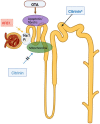New perspectives in application of kidney biomarkers in mycotoxin induced nephrotoxicity, with a particular focus on domestic pigs
- PMID: 37125184
- PMCID: PMC10140568
- DOI: 10.3389/fmicb.2023.1085818
New perspectives in application of kidney biomarkers in mycotoxin induced nephrotoxicity, with a particular focus on domestic pigs
Abstract
The gradual spread of Aspergilli worldwide is adding to the global shortage of food and is affecting its safe consumption. Aspergillus-derived mycotoxins, including aflatoxins and ochratoxin A, and fumonisins (members of the fusariotoxin group) can cause pathological damage to vital organs, including the kidney or liver. Although the kidney functions as the major excretory system in mammals, monitoring and screening for mycotoxin induced nephrotoxicity is only now a developmental area in the field of livestock feed toxicology. Currently the assessment of individual exposure to mycotoxins in man and animals is usually based on the analysis of toxin and/or metabolite contamination in the blood or urine. However, this requires selective and sensitive analytical methods (e.g., HPLC-MS/MS), which are time consuming and expensive. The toxicokinetic of mycotoxin metabolites is becoming better understood. Several kidney biomarkers are used successfully in drug development, however cost-efficient, and reliable kidney biomarkers are urgently needed for monitoring farm animals for early signs of kidney disease. β2-microglobulin (β2-MG) and N-acetyl-β-D-glucosaminidase (NAG) are the dominant biomarkers employed routinely in environmental toxicology research, while kidney injury molecule 1 (KIM-1) and neutrophil gelatinase-associated lipocalin (NGAL) are also emerging as effective markers to identify mycotoxin induced nephropathy. Pigs are exposed to mycotoxins due to their cereal-based diet and are particularly susceptible to Aspergillus mycotoxins. In addition to commonly used diagnostic markers for nephrotoxicity including plasma creatinine, NAG, KIM-1 and NGAL can be used in pigs. In this review, the currently available techniques are summarized, which are used for screening mycotoxin induced nephrotoxicity in farm animals. Possible approaches are considered, which could be used to detect mycotoxin induced nephropathy.
Keywords: KIM-1; NAG; NGAL biomarkers, mycotoxin induced nephrotoxicity; animal toxicity; kidney biomarkers; mycotoxins; nephrotoxicity.
Copyright © 2023 Ráduly, Szabó, Mézes, Balatoni, Price, Dockrell, Pócsi and Csernoch.
Conflict of interest statement
The authors declare that the research was conducted in the absence of any commercial or financial relationships that could be construed as a potential conflict of interest.
Figures


References
-
- Abbas H. K., Wilkinson J. R., Zablotowicz R. M., Accinelli C., Abel C. A., Bruns H. A., et al. . (2009). Ecology of aspergillus flavus, regulation of aflatoxin production, and management strategies to reduce aflatoxin contamination of corn. Toxin Rev. 28, 142–153. doi: 10.1080/15569540903081590 - DOI
Publication types
LinkOut - more resources
Full Text Sources
Research Materials
Miscellaneous

